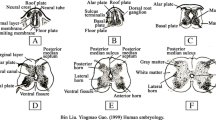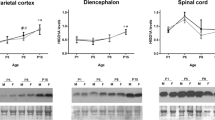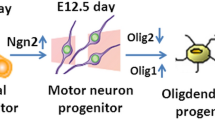Abstract
Several cellular and molecular events responsible for the development of the central nervous system (CNS), particularly those related to the development of ordered neural connections, occur during the first days of postnatal life, being days 1 through 10 a critical period to reach maturity and establish innervations. We have previously characterized hypoxia-induced gene 1 (Hig-1) and described an increase in its expression from day 1 to 15 of postnatal life in the spinal cord. Hig-1 mRNA has an open reading frame for a 93 amino acid protein, but its function has not been completely elucidated. Recently, several analyses in many cell types have related Hig-1 expression with differentiation or cell death/survival balance. With the aim of further characterizing the presence of Hig-1 in the CNS, we analyzed the cellular distribution of HIG-1 protein in rat's spinal cord at postnatal days 1, 8, 15, and 90 (P1–P90). We found an interesting change in the protein expression pattern, shifting from neurons at P1 to glial cells at P90, which points towards a functional role for this protein in the spinal cord throughout development. We also compared the protein distribution with the cellular distribution of the mRNA and of an antisense RNA.



Similar content being viewed by others
References
Almeida A, Almeida J, Bolanos JP, Moncada S (2001) Different responses of astrocytes and neurons to nitric oxide: the role of glycolytically generated ATP in astrocyte protection. Proc Natl Acad Sci U S A 98:15294–15299
An HJ, Shin H, Jo SG, Kim YJ, Lee JO, Paik SG, Lee H (2011) The survival effect of mitochondrial Higd-1a is associated with suppression of cytochrome C release and prevention of caspase activation. Biochim Biophys Acta Epub ahead of print
Angeloni C, Spencer JP, Leoncini E, Biagi PL, Hrelia S (2007) Role of quercetin and its in vivo metabolites in protecting H9c2 cells against oxidative stress. Biochimie 89:73–82
Bak M, Silahtaroglu A, Moller M, Christensen M, Rath MF, Skryabin B, Tommerup N, Kauppinen S (2008) MicroRNA expression in the adult mouse central nervous system. RNA 14:432–444
Bambrick L, Kristian T, Fiskum G (2004) Astrocyte mitochondrial mechanisms of ischemic brain injury and neuroprotection. Neurochem Res 29:601–608
Barker AJ, Ullian EM (2008) New roles for astrocytes in developing synaptic circuits. Commun Integr Biol 1:207–211
Bedo G, Vargas M, Ferreiro MJ, Chalar C, Agrati D (2005) Characterization of hypoxia induced gene 1: expression during rat central nervous system maturation and evidence of antisense RNA expression. Int J Dev Biol 49:431–436
Cahoy JD, Emery B, Kaushal A, Foo LC, Zamanian JL, Christopherson KS, Xing Y, Lubischer JL, Krieg PA, Krupenko SA et al (2008) A transcriptome database for astrocytes, neurons, and oligodendrocytes: a new resource for understanding brain development and function. J Neurosci 28:264–278
Carninci P (2010) RNA dust: where are the genes? DNA Res 17:51–59
Chanrion M, Negre V, Fontaine H, Salvetat N, Bibeau F, Mac Grogan G, Mauriac L, Katsaros D, Molina F, Theillet C, Darbon JM (2008) A gene expression signature that can predict the recurrence of tamoxifen-treated primary breast cancer. Clin Cancer Res 14:1744–1752
Chen L, Fink T, Zhang XY, Ebbesen P, Zachar V (2005) Quantitative transcriptional profiling of ATDC5 mouse progenitor cells during chondrogenesis. Differentiation 73:350–363
Chen YH, Wang YH, Yu TH, Wu HJ, Pai CW (2009) Transgenic zebrafish line with over-expression of Hedgehog on the skin: a useful tool to screen Hedgehog-inhibiting compounds. Transgenic Res 18:855–864
Clarac F, Pearlstein E, Pflieger JF, Vinay L (2004) The in vitro neonatal rat spinal cord preparation: a new insight into mammalian locomotor mechanisms. J Comp Physiol A Neuroethol Sens Neural Behav Physiol 190:343–357
Coggeshall RE, Pover CM, Fitzgerald M (1994) Dorsal root ganglion cell death and surviving cell numbers in relation to the development of sensory innervation in the rat hindlimb. Brain Res Dev Brain Res 82:193–212
Coudert AE, Pibouin L, Vi-Fane B, Thomas BL, Macdougall M, Choudhury A, Robert B, Sharpe PT, Berdal A, Lezot F (2005) Expression and regulation of the Msx1 natural antisense transcript during development. Nucleic Acids Res 33:5208–5218
Denko N, Schindler C, Koong A, Laderoute K, Green C, Giaccia A (2000) Epigenetic regulation of gene expression in cervical cancer cells by the tumor microenvironment. Clin Cancer Res 6:480–487
Dinger ME, Pang KC, Mercer TR, Crowe ML, Grimmond SM, Mattick JS (2009) NRED: a database of long noncoding RNA expression. Nucleic Acids Res 37:D122–D126
Garcia AD, Petrova R, Eng L, Joyner AL (2010) Sonic hedgehog regulates discrete populations of astrocytes in the adult mouse forebrain. J Neurosci 30:13597–13608
Gavriouchkina D, Fischer S, Ivacevic T, Stolte J, Benes V, Dekens MP (2010) Thyrotroph embryonic factor regulates light-induced transcription of repair genes in zebrafish embryonic cells. PLoS One 5:e12542
Haeberlein SL (2004) Mitochondrial function in apoptotic neuronal cell death. Neurochem Res 29:521–530
Jin K, Mao XO, Eshoo MW, del Rio G, Rao R, Chen D, Simon RP, Greenberg DA (2002) cDNA microarray analysis of changes in gene expression induced by neuronal hypoxia in vitro. Neurochem Res 27:1105–1112
Kasai K, Yamashita T, Yamaguchi A, Yoshiya K, Kawakita A, Tanaka H, Sugimoto H, Tohyama M (2003) Induction of mRNAs and proteins for Na/K ATPase alpha1 and beta1 subunits following hypoxia/reoxygenation in astrocytes. Brain Res Mol Brain Res 110:38–44
Lattanzi W, Bernardini C, Gangitano C, Michetti F (2007) Hypoxia-like transcriptional activation in TMT-induced degeneration: microarray expression analysis on PC12 cells. J Neurochem 100:1688–1702
Lipton P (1999) Ischemic cell death in brain neurons. Physiol Rev 79:1431–1568
Lowrie MB, Lawson SJ (2000) Cell death of spinal interneurones. Prog Neurobiol 61:543–555
Mercer TR, Dinger ME, Sunkin SM, Mehler MF, Mattick JS (2008) Specific expression of long noncoding RNAs in the mouse brain. Proc Natl Acad Sci U S A 105:716–721
Plenderleith MB, Wright LL, Snow PJ (1992) Expression of lectin binding in the superficial dorsal horn of the rat spinal cord during pre- and postnatal development. Brain Res Dev Brain Res 68:103–109
Salnikow K, Davidson T, Zhang Q, Chen LC, Su W, Costa M (2003) The involvement of hypoxia-inducible transcription factor-1-dependent pathway in nickel carcinogenesis. Cancer Res 63:3524–3530
Slezak M, Pfrieger FW (2003) New roles for astrocytes: regulation of CNS synaptogenesis. Trends Neurosci 26:531–535
Thrash-Bingham CA, Tartof KD (1999) aHIF: a natural antisense transcript overexpressed in human renal cancer and during hypoxia. J Natl Cancer Inst 91:143–151
Todd KJ, Serrano A, Lacaille JC, Robitaille R (2006) Glial cells in synaptic plasticity. J Physiol Paris 99:75–83
Ullian EM, Harris BT, Wu A, Chan JR, Barres BA (2004) Schwann cells and astrocytes induce synapse formation by spinal motor neurons in culture. Mol Cell Neurosci 25:241–251
Vallon-Christersson J, Staaf J, Kvist A, Medstrand P, Borg A, Rovira C (2007) Non-coding antisense transcription detected by conventional and single-stranded cDNA microarray. BMC Genomics 8:295
Vinay L, Brocard F, Clarac F (2000a) Differential maturation of motoneurons innervating ankle flexor and extensor muscles in the neonatal rat. Eur J Neurosci 12:4562–4566
Vinay L, Brocard F, Pflieger JF, Simeoni-Alias J, Clarac F (2000b) Perinatal development of lumbar motoneurons and their inputs in the rat. Brain Res Bull 53:635–647
Vinay L, Ben-Mabrouk F, Brocard F, Clarac F, Jean-Xavier C, Pearlstein E, Pflieger JF (2005) Perinatal development of the motor systems involved in postural control. Neural Plast 12:131–139, discussion 263-172
Walton KD, Navarrete R (1991) Postnatal changes in motoneurone electrotonic coupling studied in the in vitro rat lumbar spinal cord. J Physiol 433:283–305
Wang J, Cao Y, Chen Y, Gardner P, Steiner DF (2006) Pancreatic beta cells lack a low glucose and O2-inducible mitochondrial protein that augments cell survival. Proc Natl Acad Sci U S A 103:10636–10641
Acknowledgements
The authors would like to thank Dr. Steiner (University of Chicago) for kindly providing the rabbit antibody anti-HIG-1, Dr. Flavio Zolessi and Dr. Mónica Brauer for contributing with secondary antibodies, and Dr. Yanina Panzera for her assistance in the use of image processing software.
Author information
Authors and Affiliations
Corresponding author
Rights and permissions
About this article
Cite this article
Bedó, G., Lagos, P. & Agrati, D. Temporal Distribution of Hig-1 (Hypoxia-Induced Gene 1) mRNA and Protein in Rat Spinal Cord: Changes During Postnatal Life. J Mol Neurosci 47, 666–673 (2012). https://doi.org/10.1007/s12031-012-9713-9
Received:
Accepted:
Published:
Issue Date:
DOI: https://doi.org/10.1007/s12031-012-9713-9




